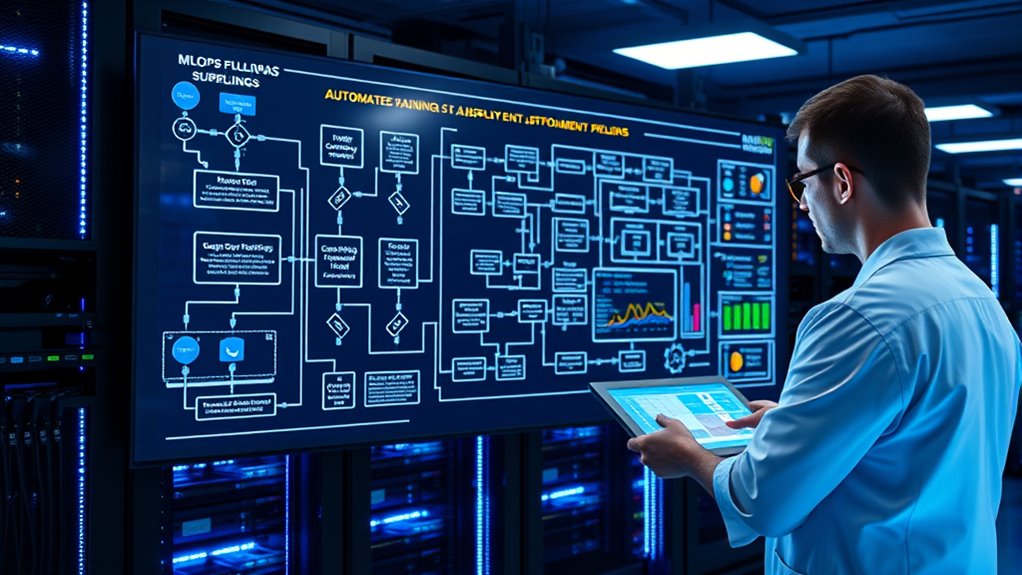In MLOps, automating your model training and deployment pipelines helps you speed up workflows, reduce manual errors, and keep models current with the latest data. You can set up automated triggers—like code commits or schedules—to initiate processes such as data ingestion, training, evaluation, and deployment. Using tools like Jenkins or Kubernetes guarantees reproducibility and scalability. Continuing your journey will reveal how these pipelines enhance reliability and streamline your machine learning operations.
Key Takeaways
- Integrate data ingestion, preprocessing, training, evaluation, and deployment into a seamless automated pipeline using tools like Jenkins or GitLab CI/CD.
- Trigger workflows automatically based on code commits, schedules, or data updates to ensure models are always current.
- Automate model evaluation with predefined metrics to select and deploy the best-performing models without manual intervention.
- Use containerization (Docker, Kubernetes) for scalable deployment, version control, and easy rollback of models in production.
- Implement continuous monitoring to detect data drift, trigger retraining, and maintain model accuracy over time.

In today’s fast-paced AI landscape, developing reliable machine learning models requires more than just building algorithms; it demands efficient automation of training and deployment processes. When you automate these pipelines, you eliminate manual tasks that can introduce errors, slow down development, and hinder scalability. Automation ensures that your models are consistently trained with the latest data, evaluated accurately, and deployed swiftly into production environments. This not only accelerates your development cycle but also improves the reliability and reproducibility of your models, which are critical for maintaining trust and compliance.
Automate training and deployment to boost reliability, scalability, and speed in your machine learning workflows.
You start by designing a pipeline that integrates data ingestion, preprocessing, model training, evaluation, and deployment into a seamless workflow. This means setting up automated triggers—like code commits or scheduled intervals—that initiate the pipeline without manual intervention. When you do this, every step becomes standardized and version-controlled, reducing the chances of discrepancies or human errors. Tools like Jenkins, GitLab CI/CD, or cloud-native solutions such as AWS CodePipeline or Google Cloud Build can orchestrate these workflows effectively. You can also incorporate data validation steps early in the process to catch anomalies or inconsistencies before they impact model performance.
As the pipeline runs, it automatically fetches the latest data, cleans it, and prepares it for training, ensuring that your models stay up-to-date with the newest information. This continuous data flow allows you to quickly experiment with different models or hyperparameters, fostering an agile development environment. Additionally, integrating best practices in model versioning ensures that each iteration is stored and can be referenced or rolled back if needed. Once training completes, automated evaluation steps compare model performance against predefined metrics, making it easy to identify the best-performing models without manual oversight. If a model passes all validation checks, the pipeline proceeds to deployment, where it’s packaged and pushed to a production environment. This deployment can be containerized using Docker or Kubernetes, which simplifies scaling and rollback procedures if needed.
Automation also facilitates monitoring and feedback loops. Once in production, your pipeline can automatically track model performance, detect drift, and trigger retraining cycles when necessary. This ongoing monitoring ensures your models remain accurate and relevant over time. By automating the entire process, you minimize downtime, improve consistency, and free up your team to focus on strategic tasks like model innovation and data quality improvements. Overall, setting up automated training and deployment pipelines transforms the way you develop machine learning models, making your AI initiatives faster, more reliable, and scalable—crucial advantages in today’s competitive landscape.
Frequently Asked Questions
How Do Pipelines Handle Model Versioning and Rollback?
Think of pipelines as your safety net, catching you when things go wrong. They handle model versioning by automatically tagging each model with a unique version number during deployment. If a new model causes issues, you can quickly roll back to a previous stable version with a simple command, like flipping a switch. This guarantees your system stays resilient, and your models remain reliable, no matter what surprises come your way.
What Are Best Practices for Pipeline Security and Access Control?
You should implement strong authentication and authorization controls to restrict pipeline access. Use role-based access control (RBAC) to assign permissions based on responsibilities, and encrypt sensitive data in transit and at rest. Regularly audit access logs for unusual activity, and keep your pipeline software up to date with security patches. Additionally, consider integrating secrets management tools to securely handle API keys and credentials, ensuring your pipeline remains protected against threats.
How Do Pipelines Integrate With Real-Time Data Streams?
You connect your pipelines with real-time data streams by creating continuous, consistent channels that capture and process data promptly. You set up scalable, secure systems to swiftly synchronize streams with your models, ensuring seamless synchronization. By leveraging streaming platforms like Kafka or Apache Flink, you enable real-time insights, rapid reactions, and reliable updates, making your pipelines proactive and precise. This integration keeps your models current and your operations optimized.
What Tools Support Multi-Cloud Deployment in MLOPS Pipelines?
You can use tools like Kubeflow, MLflow, and TensorFlow Extended (TFX) to support multi-cloud deployment in MLOps pipelines. These platforms enable you to orchestrate, manage, and deploy models across various cloud providers such as AWS, Azure, and Google Cloud. They offer flexibility, scalability, and vendor neutrality, making it easier for you to implement seamless, reliable multi-cloud strategies in your machine learning workflows.
How Is Pipeline Scalability Ensured During High-Volume Training?
Imagine your pipeline as a river that needs to flow smoothly even during a flood. You guarantee scalability by leveraging cloud-native tools like Kubernetes, which dynamically allocates resources based on demand, and distributed training frameworks like Horovod or TensorFlow, to split workloads across multiple nodes. Monitoring and auto-scaling features keep your training process efficient, preventing bottlenecks and ensuring your high-volume training runs seamlessly, no matter how big the data gets.
Conclusion
Think of your MLOps pipeline as a well-oiled machine, seamlessly turning raw data into valuable insights. By automating model training and deployment, you’re guiding your project along a smooth, steady track, avoiding bottlenecks and surprises. Embrace automation as your trusted engine, powering your journey from data to deployment with speed and reliability. With this setup, you’re not just riding the wave—you’re steering it confidently toward success.









